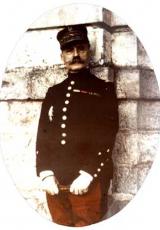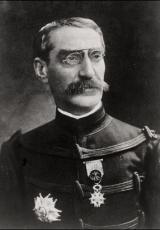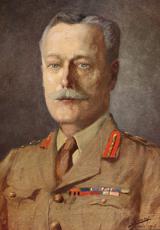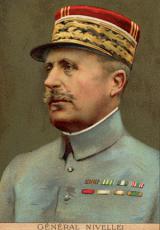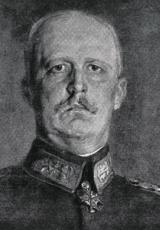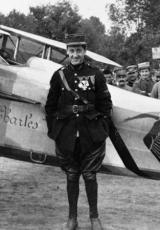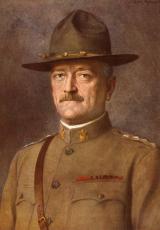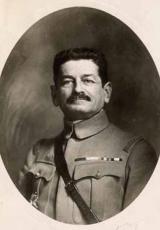La première guerre mondiale dans le Nord
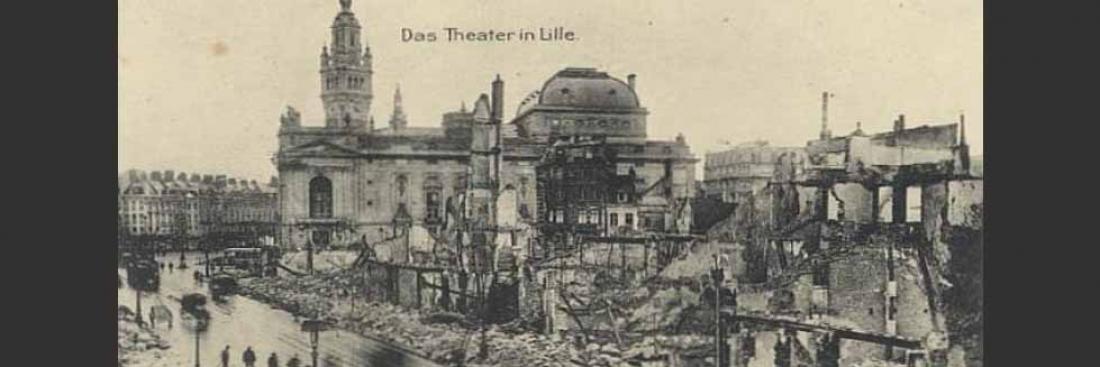
Corps 1
In August 1914, when the German troops enter France between Sambre and Escaut, the exodus of the population doesn't help the battles of the French and their allies. During the retreat many battles will take place; British in Landrecies, French in Guise. Here the V army Lanzrezac, gives the opportunity to the troops of Kaiser to pass temporarily the bridge of Oise. At the beginning of September in Ourcq, General Joffre, supported by the British, gives the order to the troops of General Maunoury, subordinated Gallieni, commander of the garrison of Paris, to attack the 1st German army Von Kluck. This is the beginning of the battle of Marne, which will be quickly focused on the regions of Sézanne and Fère-Champenoise. September 10th the Germans pull back to Aisne and its heights which dominate for instance the Chemin des Dames. Here they rise a defensive line, by using in particular the big forts, built by the French after the war of 1870.
Corps 2
The front is established from the Vosges to the Picardie. The belligerents try to outflank in the west towards the free ground: it's the race to the sea, during which the battle of Peronne, Arras, of the valleys of Artois and Mont de Flandre will take place. Lille is occupied. In Flandres, the Belgian army, commanded by king Albert I allied to the French and leaded by General Foch, settled in Cassel and resists on the Yser line. The English hold out in Ypres. The battles around Dixmunde are raging furiously and the flood is an invaluable ally. Dixmude falls on November 10th. The Yser line, also known as Boyau de la Mort (communication trench of death) and Ypres resist, despite the bombardments. The battles are intense around the crest of Messins between Ypres and Lys. During the entire war this zone will be the scene of bloody battles and the local cemeteries testify the massacre inflicted in the two camps. In Carency near Arras and especially in Weppes, between Armentières and La Bassée the frontline is stuck in spite of the allied attempts of December 1914. In Neuve-Chapelle the British will face a terrible failure; the Indian Army is beaten. In May 1915 the attack of the Salient d'Aubers will take place but the troops will literally run into the German fortifications. It will end with 10 000 killed and wounded soldiers. In April 1915, towards Ypres, English mines cause a huge explosion which will be at the origin of an artificial hill of 60 meters, called therefore Hill 60. The Germans will then retort by using their new chlorine gas weapons, which will cause thousands of victims, among them also Breton fighters. Ypres is shelled and burned but the soldiers resist in their trenches. Between May and July Joffre concentrates his effort on the hills of Artois, Ablain, Saint Nazaire, Neuville Saint Vaast and inthe areas of Vimy, Notre Dame de Lorette, Souchez, Mont Saint Eloi, la Targette, Givenchy, Carency. It will be a terrible failure : 140 000 French will die. In September a new offensive is however organised. Like they did in May the English attack Loos in Gohelle. Souchez is occupied, but the city is completely destroyed. In the two camps the number of wounded and killed men is enormous.
At the beginning of the year 1916, Joffre succeeds in convincing the British to organize an offensive, under the authority of the General Foch, in Somme from the valley of Ancre towards Bapaume, while the French in the south of Somme will attack Péronne. English, Canadians, Australians, Turkish, Africans Scottish and Irish are situated in the valley around Albert. Their objective is to dislodge the Germans from the height of Beaumont-Hamel, Thiepval, Pozières, Fricourt, Montauban, Combles and Maricourt. Here the Germans have the time to settle, organise and fortify themselves and the artillery shelling of the last week of June proved to be insufficient, when the attack of June 1st took place.
The machine-guns mow down the troops : on that day 30 000 men will die. Nevertheless the offensive will continue during several months of the year 1916, in different phases. This attack is supported by the aviation which shells the German trenches, then in September by the tanks, near Coucelette. At the end of November the situation is evaluated, counting nearly one million dead and wounded men as far as the allies are concerned, from the side of the Germans the victims are more than 300 000. Verdun is left behind... while the frontlines advanced only 10 to 15 Km, without reaching neither Péronne nor Bapaume. Nowadays the region of Somme counts more then 400 British cemeteries. But at the same time, to reinforce the front of the Somme, the German army had to renounce to pass by Verdun: one of the goals of the offensive was achieved. It is also during this summer that another fatal battle will be engaged by the Australian corps in the zone of Fromelles, between Lille and Béthune. General Haig asked them to launch an offensive towards Lille, in order to fix the German troops and to avoid that they reinforce the front in Somme. The 5th Australian division launch the attack on July 19th but is snapped away by the Bavarians. The 61st division fails as well. The Australians loose more then 5500 men and the British more then 1300. In 1917 the Germans pull back in the Hindenbourg line (or Siegfried line), between Lens and Soissons. Here they devastate the regions they leave behind them. This retreat is completed by the seizure on march 17th of Bapaume by the Australians. The new general of the French troops Nivelle has now only to worry to reduce the ex-pocket of Noyon. He decides then to attack the centre, i.e. the Chemin des Dames towards Laon, in seizing the height and the galleries which are methodically fortified by the Germans. The Caverne du Dragon (Cave of the Dragon), typical example owes him this name. Beforehand he obtains the agreement of the allies to execute on April 9th a diversion attack in Artois. Supported by the artillery, the aviation and the mine explosions placed under the German lines, English, Australians, New Zealander and Canadians attack. The Canadians seize Crête de Vimy. In Bullecourt the Australians are decimated by the German artillery. In one month they lose 10 000 men.
At the Chemin de Dames between April 10th and 16th, the French artillery prepares the battlefield. But during the morning of the attack on the 16th the German machine guns shoot the attackers. The 2/3 of the Senegalese division is destroyed in a few hours. On May 15th, the human losses are out of proportion, compared with the amount of terrain conquered. Nivelle is replaced by Pétain. In the month of April, in 15 days of fights, nearly 150 000 men were lost and among those 40 000 died. This indeed wasn't enough to prevent a second attack on May 4th. This slaughter caused several mutinies which marshal Pétain tried to suppress. At the same time he tried to save the men and to wait for necessary reinforcements, before preparing other offensives. The engagements pursue during the summer. Then in October a French attack in the west will seize the fort of Malmaison and Moulin de Laffaux. The Germans surge back and lose 30 000 men and the Chemin des Dames.
In the same year 1917 the English general Haig wants to launch a decisive offensive in Flandres. Yhanks to the huge mine explosions hidden under the ground by English sappers, on June 7th the New-Zealanders and the English seize Massines but will not progress any further. In July 31st a third battle in Ypres will take place, marked by the gas, heavy bombardments and continous rain. Houthulst and Poelkapelle are conquered. In Poelkapelle the French pilot Georges Guynemer was killed. In November the Canadians seize Passchendaele. This battle didn't serve much, since they advanced less then 10 km and lost 300 000 men. On the German side 260 000 men are lost. The region of Ypres is scattered with memorials and graveyards. November 1917 the English use 400 tanks and break through the adversaries' line, towards Cambrai. Nevertheless they won't be able to exploit their initial success and the front almost returns to its old layout.
1918
In 1918 the Germans are conscious of their temporary superiority . Because of the Russian revolution the eastern front was eliminated : Soon the American army will be operational and the superiority of the allies in terms of troops and material will be real. Thus they decide to attack without losing time. March 21st the offensive of Ludendorff is launched from Oise to Scarpe, they manage to open a pocket between the English, situated near the coast and the French, worried to protect Paris. It's at this moment the allies unite in Dardanelles and entrust the command to General Foch. In Somme, Aisne and Flandres the German move forward. Messines is seizure but in Kemmel, where the allies lose 250 000 men the German are not able to pass. In Aisne, from the forest of St Gobain the German shells reach Paris, while the troops of Ludendorff seize the Chemin des Dames, Soissons, Château-Thierry. Under the order of Pershing the American marines resist in the forest Belleau, where in particular officer Patton and officer Marshal distinguish themselves. Then in July 16th it's the French troops turn to resist in Reims. The 17th the second battle of Marne forces the Germans to move back towards Aisne. Organized by General Mangin, this battle is sustained by the Americans and the armoured division, the tanks and the planes. August 8th in the front of Somme between the valley of Ancre and Avre, the tanks make a decisive breakthrough. Massively equipped with modern armaments and allied battalions, the imperial army moves back in order but being sure of the final defeat, while behind them there are rumblings of revolution. November 7th in Haudroy, in the region of Aisne the German plenipotentiaries pass the front line, where they are lead to Compiègne-Rethondes, where they request the armistice. It will be signed November 11th and will come into effect at 11 o'clock. To celebrate this event 1 200 canon ammunitions are shot. The hostilities finally ended, the Allies are the winners but indeed the French ground is completely devastated in the north and the east. Nearly 200 communes of Pas-de-Calais are destroyed. The human assessment of the war is as following: nine million people died; 20 million have been wounded; millions of families are ruined forever. Beside the Germans and British who where massively involved in the conflict, it is important to remember all the soldiers who came from all over the world: America, Africa, Asia. All these men died in Europe during these fratricidal fights. From now on the world has changed.
Personalities
Commemorative sites
- Saint-Charles-de-Potyze National Cemetery
- Musée Franco-Australien
- Canadian Memorial
- La Chapelle du Souvenir Français
- La Boisselle
- La salle du "Commandement Unique" à Doullens
- Bullecourt
- La Caverne du Dragon
- Museum of Flandres
- Yser Tower
- Musée de la Mémoire de Belleau 1914-1918
- Aisne-Marne American Cemetery at Belleau
- La Caverne du Dragon
- The carriage of the armistice, Rethondes
- Thiepval Visitor Centre,
- La salle du "Commandement Unique" à Doullens
- La Malmaison
- Peronne



